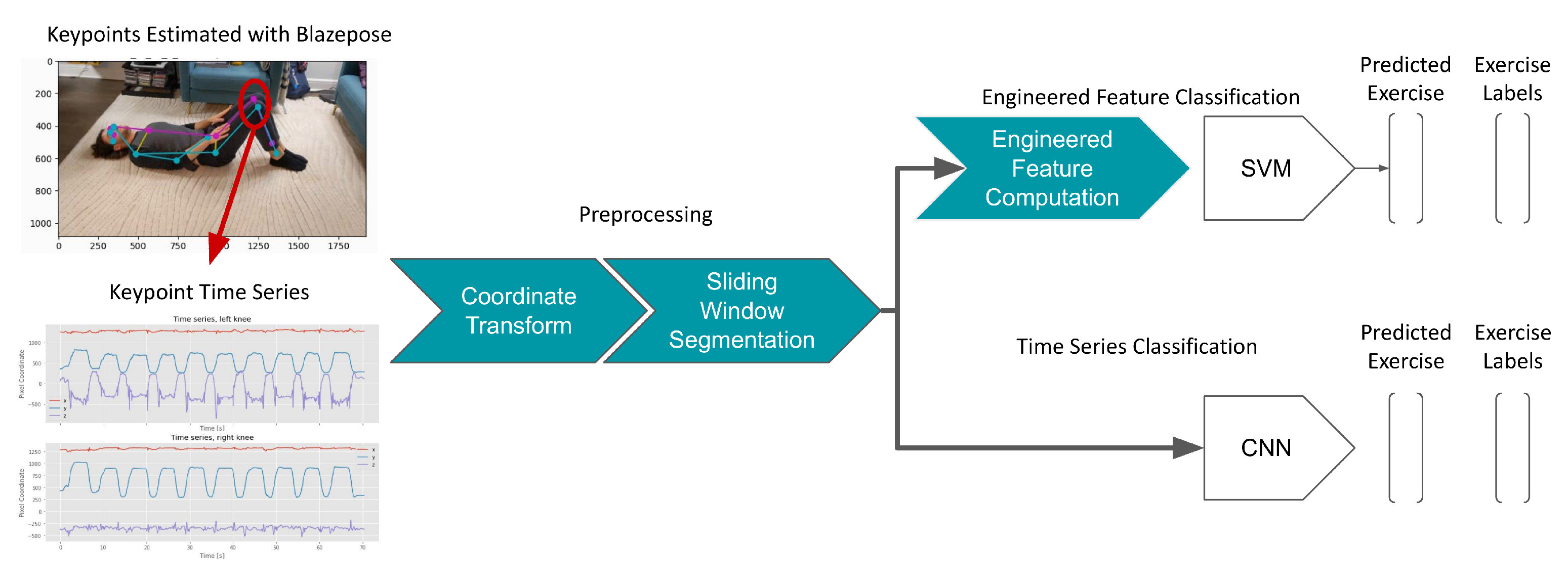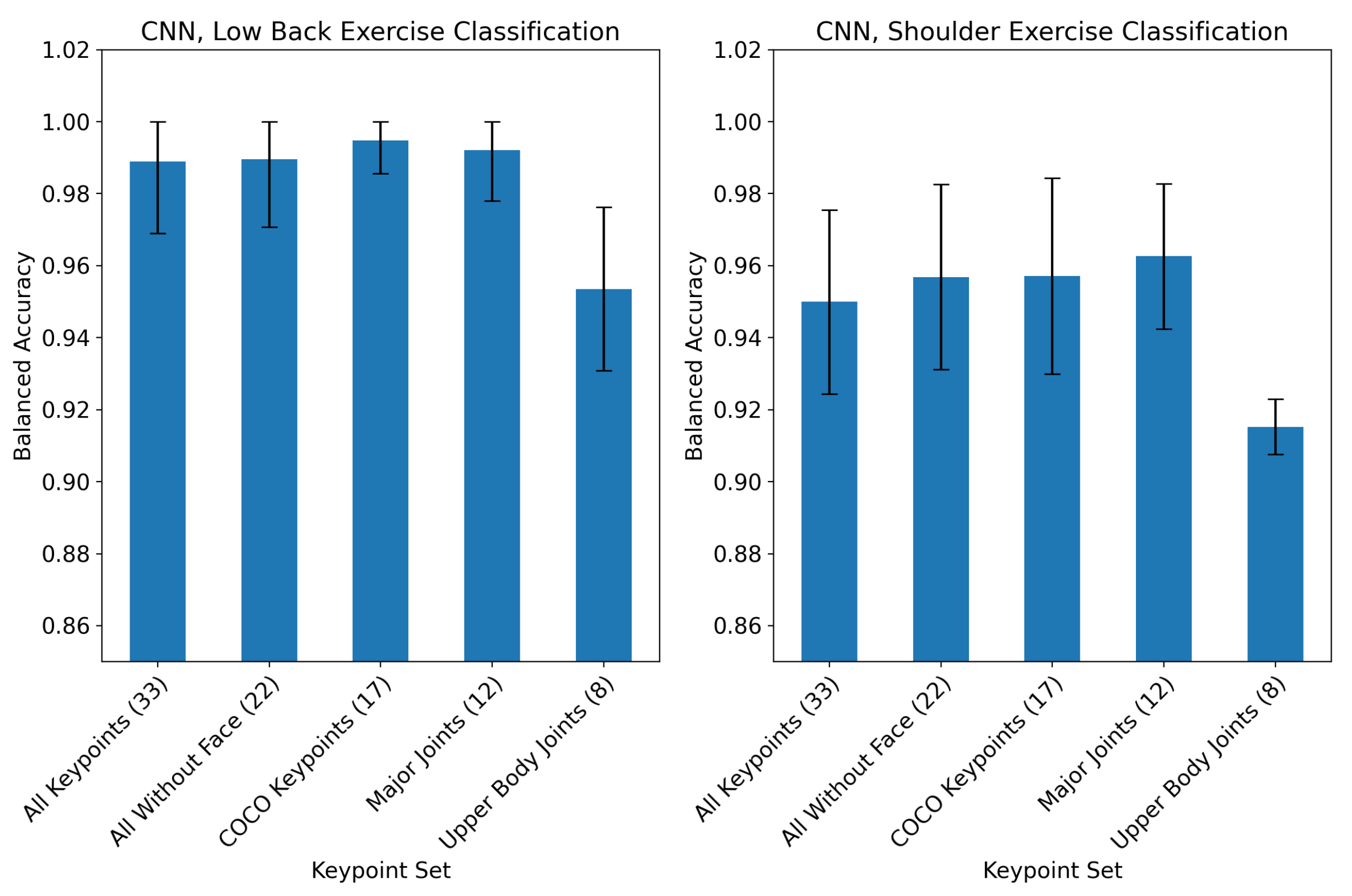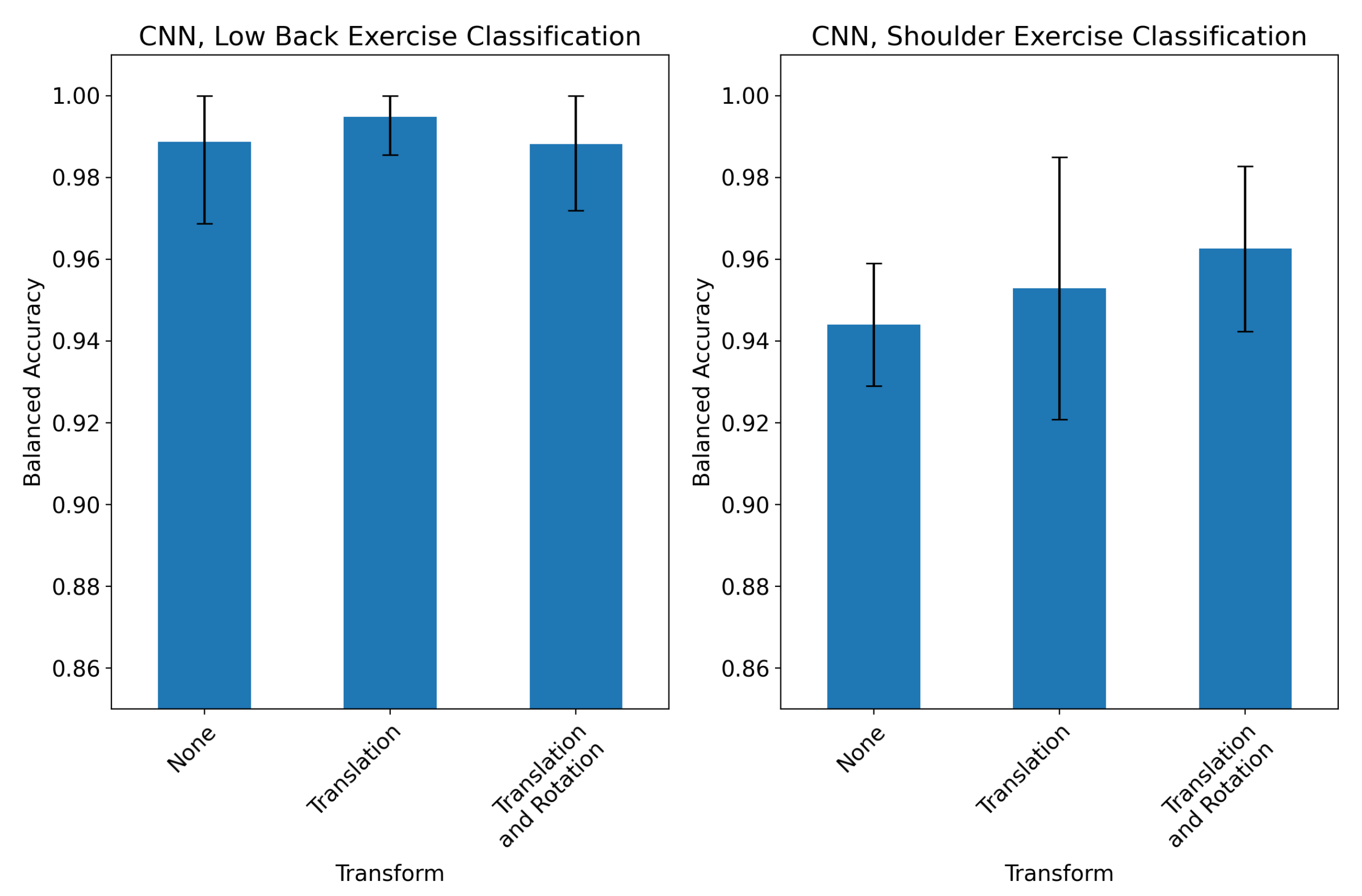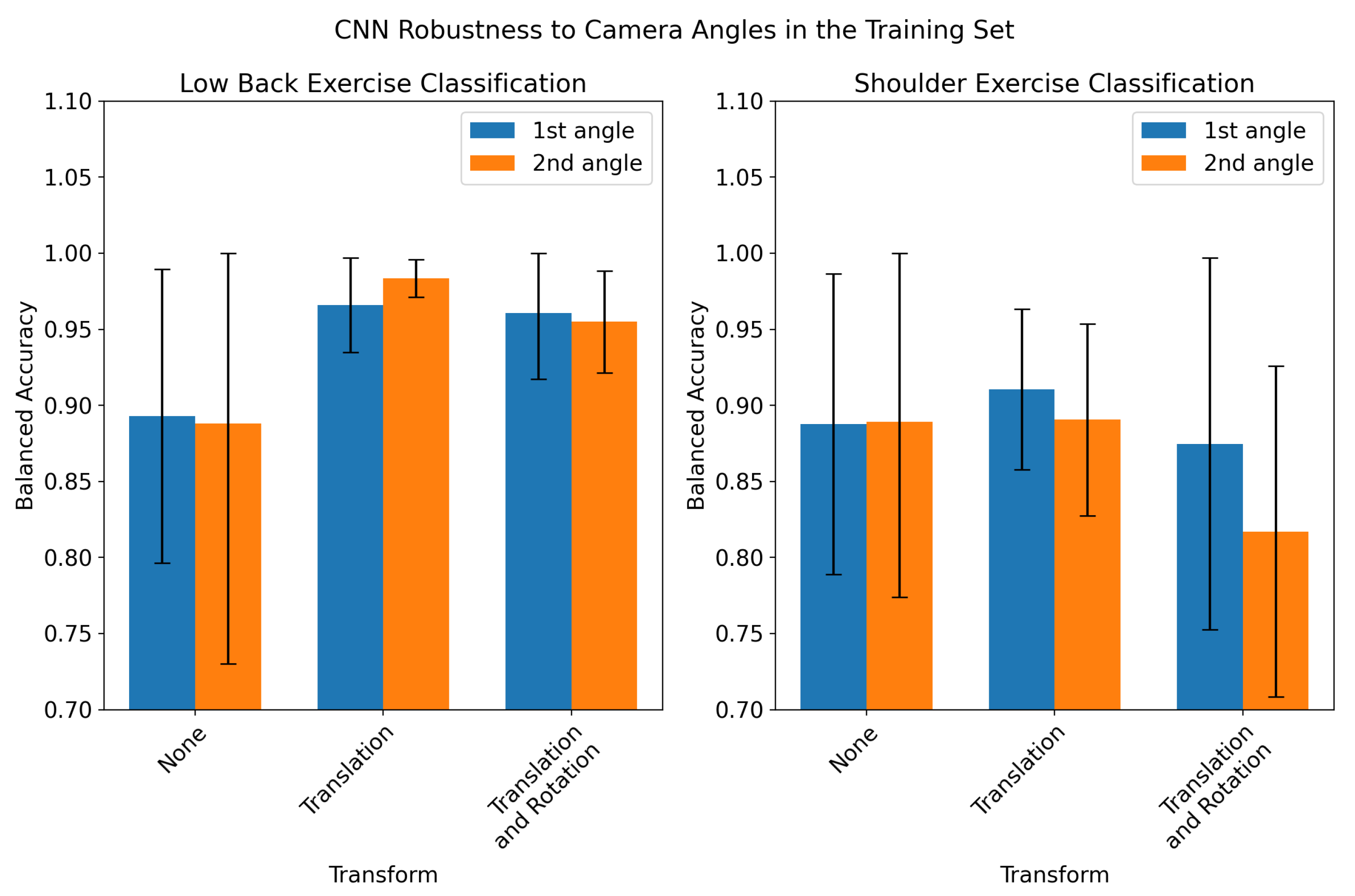Physiotherapy Exercise Classification with Single-Camera Pose Detection and Machine Learning
Abstract
1. Introduction
2. Materials and Methods
2.1. Dataset
2.2. Preprocessing
2.3. Exercise Classification Models
2.4. Baseline Model Optimization
2.5. Performance Evaluation
2.6. Experiments
2.6.1. Keypoint Combinations
- All Keypoints: The full set of 33 BlazePose keypoints.
- All Without Face: Twenty-two keypoints containing the BlazePose set without keypoints on the face.
- COCO Keypoints: Set of 17 keypoints used in the COCO [42] dataset. These are a subset of the BlazePose set which contain fewer keypoints on the face and hands.
- Major joints: Twelve keypoints made up of the shoulders, elbows, wrists, hips, knees and ankles.
- Upper Body Joints: Eight keypoints made up of the shoulders, elbows, wrists, and hips.
2.6.2. Coordinate Transforms
- None: No transform was applied. The raw keypoints in image pixel coordinates from BlazePose were passed to the CNN.
- Translation: The translation transformation was applied to all keypoint timeseries.
- Translation and rotation: The translation followed by a rotation was applied to all keypoint timeseries.
2.6.3. Camera Angles
2.6.4. Training Saturation
3. Results
3.1. Baseline Models
3.2. Keypoint Combinations
3.3. Coordinate Transforms
3.4. Camera Angles
3.5. Training Saturation
4. Discussion
5. Conclusions
Author Contributions
Funding
Institutional Review Board Statement
Informed Consent Statement
Data Availability Statement
Acknowledgments
Conflicts of Interest
Abbreviations
| SVM | Support vector machine |
| CNN | Convolutional neural network |
| LBP | Low-back pain |
| IMU | Inertial measurement unit |
Appendix A. List of Low-Back and Shoulder Physiotherapy Exercises
| Exercise Name | Symmetrical |
|---|---|
| Abduction stretching | Yes |
| Flexion | No |
| Wall push-ups | Yes |
| External rotation | No |
| Internal rotation | No |
| Row | Yes |
| Pull downs | Yes |
| Exercise Name | Symmetrical |
|---|---|
| Sustained prone position | Yes |
| Dynamic extension in standing | Yes |
| Dynamic extension in lying | Yes |
| Dynamic flexion in lying | Yes |
| Flexion rotation with one leg | No |
| Flexion rotation with both legs | No |
| Dynamic side glide in standing | No |
Appendix B. Sample Pose Detection Time Series

References
- Morris, A.C.; Singh, J.A.; Bickel, C.S.; Ponce, B.A. Exercise therapy following surgical rotator cuff repair. Cochrane Database Syst. Rev. 2015. [Google Scholar] [CrossRef]
- Van der Windt, D.; Koes, B.W.; De Jong, B.A.; Bouter, L.M. Shoulder disorders in general practice: Incidence, patient characteristics, and management. Ann. Rheum. Dis. 1995, 54, 959–964. [Google Scholar] [CrossRef]
- Luime, J.; Koes, B.; Hendriksen, I.; Burdorf, A.; Verhagen, A.; Miedema, H.; Verhaar, J. Prevalence and incidence of shoulder pain in the general population; a systematic review. Scand. J. Rheumatol. 2004, 33, 73–81. [Google Scholar] [CrossRef] [PubMed]
- Fatoye, F.; Gebrye, T.; Odeyemi, I. Real-world incidence and prevalence of low back pain using routinely collected data. Rheumatol. Int. 2019, 39, 619–626. [Google Scholar] [CrossRef]
- Strine, T.W.; Hootman, J.M. US national prevalence and correlates of low back and neck pain among adults. Arthritis Care Res. 2007, 57, 656–665. [Google Scholar] [CrossRef]
- Kato, S.; Demura, S.; Shinmura, K.; Yokogawa, N.; Kabata, T.; Matsubara, H.; Kajino, Y.; Igarashi, K.; Inoue, D.; Kurokawa, Y.; et al. Association of low back pain with muscle weakness, decreased mobility function, and malnutrition in older women: A cross-sectional study. PLoS ONE 2021, 16, e0245879. [Google Scholar] [CrossRef]
- Kuhn, J.E.; Dunn, W.R.; Sanders, R.A.; An, Q.; Baumgarten, K.M.; Bishop, J.Y.; Brophy, R.H.; Carey, J.L.; Holloway, B.G.; Jones, G.L.; et al. Effectiveness of physical therapy in treating atraumatic full-thickness rotator cuff tears: A multicenter prospective cohort study. J. Shoulder Elb. Surg. 2013, 22, 1371–1379. [Google Scholar] [CrossRef]
- Airaksinen, O.; Brox, J.I.; Cedraschi, C.; Hildebrandt, J.; Klaber-Moffett, J.; Kovacs, F.; Mannion, A.F.; Reis, S.; Staal, J.; Ursin, H.; et al. European guidelines for the management of chronic nonspecific low back pain. Eur. Spine J. 2006, 15, s192. [Google Scholar] [CrossRef]
- Narvani, A.; Imam, M.; Godenèche, A.; Calvo, E.; Corbett, S.; Wallace, A.; Itoi, E. Degenerative rotator cuff tear, repair or not repair? A review of current evidence. Ann. R. Coll. Surg. Engl. 2020, 102, 248–255. [Google Scholar] [CrossRef]
- Namnaqani, F.I.; Mashabi, A.S.; Yaseen, K.M.; Alshehri, M.A. The effectiveness of McKenzie method compared to manual therapy for treating chronic low back pain: A systematic review. J. Musculoskelet. Neuronal Interact. 2019, 19, 492. [Google Scholar]
- Mclean, S.; Holden, M.; Haywood, K.; Potia, T.; Gee, M.; Mallett, R.; Bhanbhro, S. Recommendations for exercise adherence measures in musculoskeletal settings: A systematic review and consensus meeting. Syst. Rev. 2014, 3, 1–6. [Google Scholar]
- Burns, D.; Boyer, P.; Razmjou, H.; Richards, R.; Whyne, C. Adherence patterns and dose response of physiotherapy for rotator cuff pathology: Longitudinal cohort study. JMIR Rehabil. Assist. Technol. 2021, 8, e21374. [Google Scholar] [CrossRef]
- Kroeze, R.J.; Smit, T.H.; Vergroesen, P.P.; Bank, R.A.; Stoop, R.; van Rietbergen, B.; van Royen, B.J.; Helder, M.N. Spinal fusion using adipose stem cells seeded on a radiolucent cage filler: A feasibility study of a single surgical procedure in goats. Eur. Spine J. 2015, 24, 1031–1042. [Google Scholar] [CrossRef]
- Argent, R.; Daly, A.; Caulfield, B. Patient involvement with home-based exercise programs: Can connected health interventions influence adherence? JMIR mHealth uHealth 2018, 6, e8518. [Google Scholar] [CrossRef]
- Nicolson, P.J.; Hinman, R.S.; Wrigley, T.V.; Stratford, P.W.; Bennell, K.L. Self-reported home exercise adherence: A validity and reliability study using concealed accelerometers. J. Orthop. Sport. Phys. Ther. 2018, 48, 943–950. [Google Scholar] [CrossRef]
- Frost, R.; Levati, S.; McClurg, D.; Brady, M.; Williams, B. What adherence measures should be used in trials of home-based rehabilitation interventions? A systematic review of the validity, reliability, and acceptability of measures. Arch. Phys. Med. Rehabil. 2017, 98, 1241–1256. [Google Scholar] [CrossRef]
- Nguyen, M.; Fan, L.; Shahabi, C. Activity Recognition Using Wrist-Worn Sensors for Human Performance Evaluation. In Proceedings of the 2015 IEEE International Conference on Data Mining Workshop (ICDMW), Atlantic City, NJ, USA, 14–17 November 2015; pp. 164–169. [Google Scholar] [CrossRef]
- Garcia-Ceja, E.; Brena, R.F.; Carrasco-Jimenez, J.C.; Garrido, L. Long-term activity recognition from wristwatch accelerometer data. Sensors 2014, 14, 22500–22524. [Google Scholar] [CrossRef]
- Yang, J.Y.; Wang, J.S.; Chen, Y.P. Using acceleration measurements for activity recognition: An effective learning algorithm for constructing neural classifiers. Pattern Recognit. Lett. 2008, 29, 2213–2220. [Google Scholar] [CrossRef]
- Burns, D.M.; Leung, N.; Hardisty, M.; Whyne, C.M.; Henry, P.; McLachlin, S. Shoulder physiotherapy exercise recognition: Machine learning the inertial signals from a smartwatch. Physiol. Meas. 2018, 39, 75007. [Google Scholar] [CrossRef]
- Burns, D.; Razmjou, H.; Shaw, J.; Richards, R.; McLachlin, S.; Hardisty, M.; Henry, P.; Whyne, C. Adherence tracking with smart watches for shoulder physiotherapy in rotator cuff pathology: Protocol for a longitudinal cohort study. JMIR Res. Protoc. 2020, 9, e17841. [Google Scholar] [CrossRef]
- Alfakir, A.; Arrowsmith, C.; Burns, D.; Razmjou, H.; Hardisty, M.; Whyne, C. Detection of Low Back Physiotherapy Exercises With Inertial Sensors and Machine Learning: Algorithm Development and Validation. JMIR Rehabil. Assist. Technol. 2022, 9, e38689. [Google Scholar] [CrossRef] [PubMed]
- Rashid, F.A.N.; Suriani, N.S.; Nazari, A. Kinect-based physiotherapy and assessment: A comprehensive. Indones. J. Electr. Eng. Comput. Sci. 2018, 11, 1176–1187. [Google Scholar] [CrossRef]
- Menolotto, M.; Komaris, D.S.; Tedesco, S.; O’Flynn, B.; Walsh, M. Motion Capture Technology in Industrial Applications: A Systematic Review. Sensors 2020, 20, 5687. [Google Scholar] [CrossRef]
- Gavrilova, M.L.; Ahmed, F.; Bari, H.; Liu, R.; Liu, T.; Maret, Y.; Kawah Sieu, B.; Sudhakar, T. Multi-Modal Motion-Capture-Based Biometric Systems for Emergency Response and Patient Rehabilitation. In Research Anthology on Rehabilitation Practices and Therapy; IGI Global: Hershey, PA, USA, 2021; pp. 653–678. [Google Scholar]
- Lee, P.; Chen, T.B.; Wang, C.Y.; Hsu, S.Y.; Liu, C.H. Detection of Postural Control in Young and Elderly Adults Using Deep and Machine Learning Methods with Joint–Node Plots. Sensors 2021, 21, 3212. [Google Scholar] [CrossRef] [PubMed]
- Tsakanikas, V.D.; Gatsios, D.; Dimopoulos, D.; Pardalis, A.; Pavlou, M.; Liston, M.B.; Fotiadis, D.I. Evaluating the performance of balance physiotherapy exercises using a sensory platform: The basis for a persuasive balance rehabilitation virtual coaching system. Front. Digit. Health 2020, 2, 545885. [Google Scholar] [CrossRef]
- Cao, Z.; Simon, T.; Wei, S.E.; Sheikh, Y. Realtime multi-person 2d pose estimation using part affinity fields. In Proceedings of the IEEE Conference on Computer Vision and Pattern Recognition, Honolulu, HI, USA, 21–26 July 2017; pp. 7291–7299. [Google Scholar]
- Votel, R.; Li, N. Next-Generation Pose Detection with Movenet and Tensorflow.js. 2021. Available online: https://blog.tensorflow.org/2021/05/next-generation-pose-detection-with-movenet-and-tensorflowjs.html (accessed on 1 November 2021).
- Bazarevsky, V.; Grishchenko, I.; Raveendran, K.; Zhu, T.; Zhang, F.; Grundmann, M. BlazePose: On-device Real-time Body Pose tracking. arXiv 2020. [Google Scholar] [CrossRef]
- Kidziński, Ł.; Yang, B.; Hicks, J.L.; Rajagopal, A.; Delp, S.L.; Schwartz, M.H. Deep neural networks enable quantitative movement analysis using single-camera videos. Nat. Commun. 2020, 11, 1–10. [Google Scholar] [CrossRef]
- Lonini, L.; Moon, Y.; Embry, K.; Cotton, R.J.; McKenzie, K.; Jenz, S.; Jayaraman, A. Video-Based Pose Estimation for Gait Analysis in Stroke Survivors during Clinical Assessments: A Proof-of-Concept Study. Digit. Biomarkers 2022, 6, 9–18. [Google Scholar] [CrossRef]
- Ramirez, H.; Velastin, S.A.; Aguayo, P.; Fabregas, E.; Farias, G. Human Activity Recognition by Sequences of Skeleton Features. Sensors 2022, 22, 3991. [Google Scholar] [CrossRef]
- McKenzie, R.; May, S. The Lumbar Spine: Mechanical Diagnosis and Therapy; Spinal Publications New Zealand Limited: Wellington, New Zealand, 2003; Volume 1. [Google Scholar]
- Lugaresi, C.; Tang, J.; Nash, H.; McClanahan, C.; Uboweja, E.; Hays, M.; Zhang, F.; Chang, C.L.; Yong, M.G.; Lee, J.; et al. Mediapipe: A framework for building perception pipelines. arXiv 2019, arXiv:1906.08172. [Google Scholar]
- Burns, D.M.; Whyne, C.M. Seglearn: A Python Package for Learning Sequences and Time Series. J. Mach. Learn. Res. 2018, 19, 1–7. [Google Scholar]
- Pedregosa, F.; Varoquaux, G.; Gramfort, A.; Michel, V.; Thirion, B.; Grisel, O.; Blondel, M.; Prettenhofer, P.; Weiss, R.; Dubourg, V.; et al. Scikit-learn: Machine Learning in Python. J. Mach. Learn. Res. 2011, 12, 2825–2830. [Google Scholar]
- Burns, D.; Boyer, P.; Arrowsmith, C.; Whyne, C. Personalized Activity Recognition with Deep Triplet Embeddings. Sensors 2022, 22, 5222. [Google Scholar] [CrossRef]
- Wang, Z.; Yan, W.; Oates, T. Time series classification from scratch with deep neural networks: A strong baseline. In Proceedings of the 2017 International Joint Conference on Neural Networks (IJCNN), Anchorage, AK, USA, 14–19 May 2017; pp. 1578–1585. [Google Scholar]
- Krizhevsky, A.; Sutskever, I.; Hinton, G.E. Imagenet classification with deep convolutional neural networks. Commun. ACM 2017, 60, 84–90. [Google Scholar] [CrossRef]
- Kingma, D.P.; Ba, J. Adam: A method for stochastic optimization. arXiv 2014, arXiv:1412.6980. [Google Scholar]
- Lin, T.Y.; Maire, M.; Belongie, S.; Hays, J.; Perona, P.; Ramanan, D.; Dollár, P.; Zitnick, C.L. Microsoft coco: Common objects in context. In Proceedings of the European Conference on Computer Vision, Zurich, Switzerland, 6–12 September 2014; Springer: Berlin/Heidelberg, Germany, 2014; pp. 740–755. [Google Scholar]
- Stenum, J.; Rossi, C.; Roemmich, R.T. Two-dimensional video-based analysis of human gait using pose estimation. PLoS Comput. Biol. 2021, 17, e1008935. [Google Scholar] [CrossRef]
- Choi, W.; Heo, S. Deep Learning Approaches to Automated Video Classification of Upper Limb Tension Test. Healthcare 2021, 9, 1579. [Google Scholar] [CrossRef]
- Chen, T.; Or, C.K. Development and pilot test of a machine learning-based knee exercise system with video demonstration, real-time feedback, and exercise performance score. In Proceedings of the Human Factors and Ergonomics Society Annual Meeting; SAGE Publications Sage CA: Los Angeles, CA, USA, 2021; Volume 65, pp. 1519–1523. [Google Scholar]
- Uhlrich, S.D.; Falisse, A.; Kidziński, Ł.; Muccini, J.; Ko, M.; Chaudhari, A.S.; Hicks, J.L.; Delp, S.L. OpenCap: 3D human movement dynamics from smartphone videos. bioRxiv 2022. [Google Scholar] [CrossRef]






| Model | Classification Task | Channels | Keypoints | Transforms | Accuracy |
|---|---|---|---|---|---|
| SVM | Low back | Major joints | Translation | 0.992 ± 0.011 | |
| SVM | Shoulder | BlazePose without face | None | 0.972 ± 0.016 | |
| CNN | Low back | COCO | Translation | 0.995 ± 0.009 | |
| CNN | Shoulder | Major joints | Translation and rotation | 0.963 ± 0.020 |
Disclaimer/Publisher’s Note: The statements, opinions and data contained in all publications are solely those of the individual author(s) and contributor(s) and not of MDPI and/or the editor(s). MDPI and/or the editor(s) disclaim responsibility for any injury to people or property resulting from any ideas, methods, instructions or products referred to in the content. |
© 2022 by the authors. Licensee MDPI, Basel, Switzerland. This article is an open access article distributed under the terms and conditions of the Creative Commons Attribution (CC BY) license (https://creativecommons.org/licenses/by/4.0/).
Share and Cite
Arrowsmith, C.; Burns, D.; Mak, T.; Hardisty, M.; Whyne, C. Physiotherapy Exercise Classification with Single-Camera Pose Detection and Machine Learning. Sensors 2023, 23, 363. https://doi.org/10.3390/s23010363
Arrowsmith C, Burns D, Mak T, Hardisty M, Whyne C. Physiotherapy Exercise Classification with Single-Camera Pose Detection and Machine Learning. Sensors. 2023; 23(1):363. https://doi.org/10.3390/s23010363
Chicago/Turabian StyleArrowsmith, Colin, David Burns, Thomas Mak, Michael Hardisty, and Cari Whyne. 2023. "Physiotherapy Exercise Classification with Single-Camera Pose Detection and Machine Learning" Sensors 23, no. 1: 363. https://doi.org/10.3390/s23010363
APA StyleArrowsmith, C., Burns, D., Mak, T., Hardisty, M., & Whyne, C. (2023). Physiotherapy Exercise Classification with Single-Camera Pose Detection and Machine Learning. Sensors, 23(1), 363. https://doi.org/10.3390/s23010363






